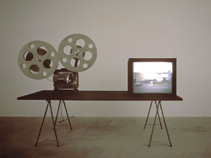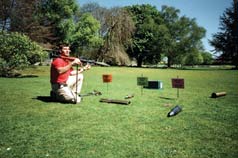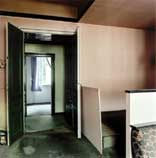| |
|||||
| Mehrfach belichtet / Multiple Exposure 22 November 2003 – 11 January 2004 |
|||||
| |
|||||
|
|
 |
 |
 |
||
Rachel Khedoori, "102nd Street", 1997 Courtesy Sammlung Hauser und Wirth, St. Gallen / Schweiz |
Bruno Serralongue, "Risk Assessment Strategies: Ballistic Danger Area", 2002 Courtesy Air de Paris |
Ricarda Denzer, "TÜR Vierzehn - reading in absence", 2001 |
|||
| |
|||||
| Artists
Matti Braun, Ricarda Denzer, Jeanne Faust / Jörn Zehe, Katarzyna Józefowicz, Rachel Khedoori, Philipp Lachenmann, Bruno Serralongue |
|||||
| |
|||||
| |
The interplay of images, those found, those influenced by and
experienced through media, those presented and those remembered, is the
focal point of the exhibition "Mehrfach belichtet / Multiple Exposure".
Although "multiple exposure" can initially be defined as a technical
irregularity –
if the film is not correctly transported in the camera, multiple
exposures on one negative can result –
it soon came to be used artistically as a purposeful style device. The video projection TÜR Vierzehn – reading in absence (2001) by Ricarda Denzer (A) primarily stages the media structure of the narrative, with which we are accustomed to interpreting our surroundings. A camera wanders through a vacant apartment. In the voice-over, six different narrators seek to reconstruct the everyday life of the former inhabitants on the basis of the remaining traces of the furnishings. Alternating between observation and fantasy, the apartment becomes both scene and "prop" for a complex and partly contradictory narrative. The film sonst wer wie du (2003) by Jeanne Faust and Jörn Zehe (D), which was made for "Mehrfach belichtet / Multiple Exposure", presents an everyday situation. It shows a midshot filmed between Hall in Tirol and Innsbruck. A brief scene is played out before this backdrop, almost like a segment from a longer film – a dialogue between a young Polish man working in the field and a local. Faust / Zehe's "film panorama" forms the stage, on which various images and expectations can be invoked: projections of what is foreign and what is familiar, a vague notion of what belongs to the "Alpine rural life", which draws its repertoire of images from Heimatfilm, landscape painting, tourism advertising, etc., colliding with the hybrid reality of a juxtaposition of agriculture, small-scale industry, and commercial businesses. The video installation Code Talker (2001) by Philipp Lachenmann (D) and the work La Pekuniala Teorio di Silvio Gesell (2002) by Matti Braun (D) take up different aspects of processes of media transfer and appropriation and the shifts of meaning associated with them. Language as a means of communication and the impossibility of direct "translations" play an important role in both cases. In Lachenmann's video portraits, a mixture of self-staging and being staged, this is already alluded to in the title "Code Talker": it refers to a secret language of the Navajos, which was developed in the early 19th century and placed at the disposal of the US Army in the World Wars of the 20th century. The point of departure for Matti Braun's La Pekuniala Teorio di Silvio Gesell is the German-French Silvio Gesell. In the early 20th century Gesell formulated the idea of so-called "free-money", which was briefly put into practice during the 1930s in Wörgl in Tirol, among other places. Consisting of a montage of documentary photographs supplemented with animated diagrams, the elliptical structure of Braun's video emphasizes this dialectic of photographic standstill and the linking of single images into a filmic movement. It is a meta-narrative that is repeatedly halted, allowing the discontinuities, cracks and omissions of the narration to become evident. Katarzyna Józefowicz (PL) condenses the omnipresence of fleeting images in daily newspapers and magazines into a spatial figure. Carpet (Black and White) (2000) is a collage of countless newspaper clippings of faces formed into a large floor work of about eleven square meters. The significance of the single image is relativized by this obsessive juxtaposition: a spatialization of the incessant circulation of already reproduced, publicized images. The photo series by Bruno Serralongue (F) show events that have a high symbolic value, which are staged for and by the media. With the protracted shooting process with a large-view camera and the sometimes elaborate formats – as in Expo 2000 (2000) – Serralongue counters transient media events with a strategy of slowness. In Risk Assessment Strategies (2002) he takes his reflection on the aesthetic, social and political dimension of images and the conditions of their production even further: taken in a training camp for journalists who are to be sent to political crisis regions and have to learn how to protect themselves from dangers in artificial scenarios, this series addresses the fabrication of the anticipated events. 102nd Street (1997) by Rachel Khedoori (AUS) turns the aspect of the multiplication of familiar perspectives into a physical-spatial experience. In a darkened room a 16mm film projector projects a two-hour film – showing slow camera pans along 102nd Street in Inglewood, California – through a diagonally mounted mirror into a viewing box. In another projection, the images are doubled on the wall behind. The filmic apparatus becomes a sculptural element that does not privilege any perspective and thus integrates its surroundings – along with the viewers: a model-like interweaving of existing and projected spaces and images and a conscious decentralization of perspectives. |
||||
| |
|||||
|
Catalogue |
|||||
| |
|||||
|
The exhibition
is supported by |
|||||
| |
|||||
|
|||||